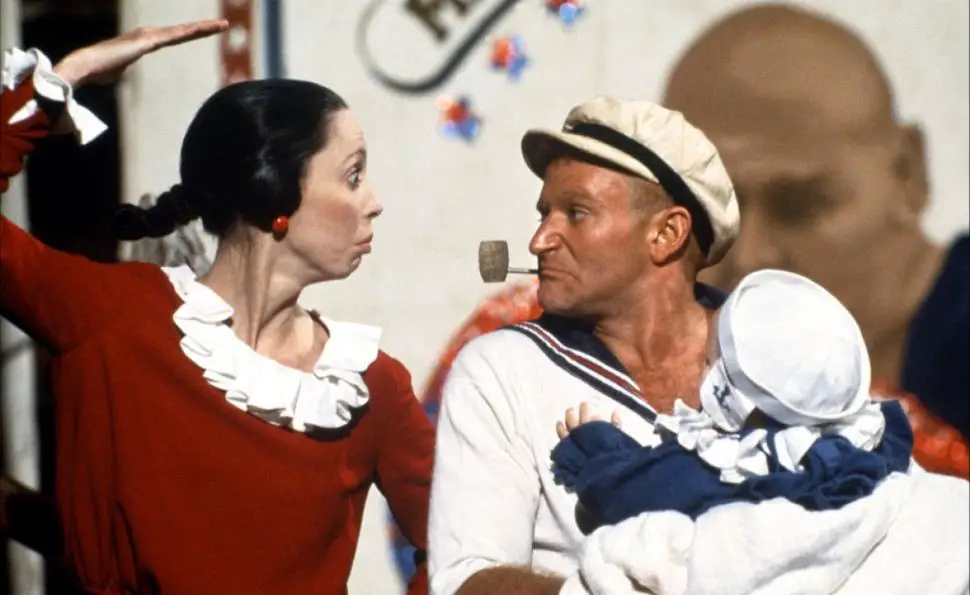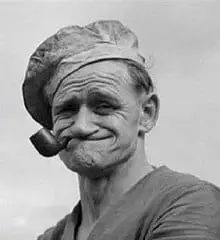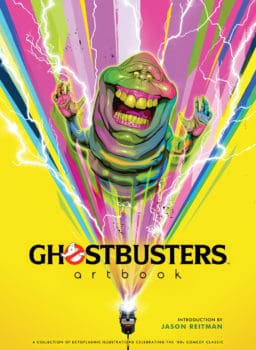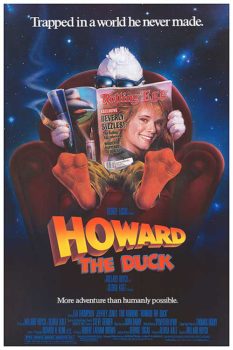
Take a famous cartoon character, add a hot new comedic actor, and put the entire thing on the big screen: how could this miss.
Popeye the movie came out in 1980 and starred Robin Williams and Shelley Duvall. Paramount made it after they failed to secure the rights to Annie, and this is the reason Popeye was a musical. It was considered a major disappointment after large expectations.
Some things just don’t pan out.
There have been many theatrical misses over the years, Howard the Duck, the Last Action Hero, and recently, Cats just to name a few. But the Popeye movie looked to be a sure thing. You had one of the hottest things going in Robin Williams, a beloved character in Popeye, and the right timing during the 80s.
But it just didn’t work out.
This will be a look back at the Popeye movie: the blockbuster that wasn’t
A Quick History on the Popeye Character

Before we look back on the Popeye movie, let’s take a quick trip back in history to look at the creation and development of the spinach-eating sailor.
Would you believe me if I told you Popeye was actually based on a real-life person? Well, he was partly based on a man named Frank “Rocky” Fiegel who lived from 1868 to 1947. Elzie Crisler Segar created the character of Popeye and he first appeared in the King Features daily comic strip.
Popeyes first appearance was on January 17, 1929, where he started out as a one-eyed sailor who got luck by rubbing the head of something they called the “wiffle hen.” The character of Olive Oyl actually predated Popeye by a good ten years, and this first appearance of Popeye was in the Olive Oyl comic strip.
Popeye was only meant to be a one-off character, and in this particular strip, he appears to help Olive’s brother Castor (eye roll) get to a casino for Castor to gamble against the mob. They hire Popeye to captain the ship and lets Castor rub the Wiffle Hen for luck. Popeye ends up getting shot in this strip but survives because, he too, rubs the head of the Wiffle Hen.
It’s probably good to point out how prevalent opium use was in the 20s and 30s…
The Rise of Popeye
The Rise of Popeye actually sounds like a pretty decent movie title. But anyway, the character of Popeye ended up being a pretty big hit despite his brief appearance. Popular reader reaction created a demand for his regular return—kind of like Steve Urkel after his onetime appearance on Family Matters.
The combo of Popeye and Olive Oyl caught on big time, and even after the death of Seger in 1938—the comic strip lived on. They brought in other artists to continue the story and we met new characters like Bluto.
Side note: Bluto and Olive Oyl were also said to be based on real people. Yikes.
It’s hard to picture, but the character of Popeye is said to be a big influence on the superheroes we know today. You have to remember that Popeye predates characters like Superman, Bat Man, Captain America, etc which are said to have drawn influence from the large-forearmed sailor.
Popeye wasn’t a superhero in the traditional sense, but he encompassed many of the traits we now associate with superheroes such as bravery, saving the damsel in distress, fending off brutish adversaries, etc.
Popeye would continue into the mainstream with animated cartoons starting as far back as 1932, and on into the 60s. There were comic books, and the “All-New Popeye Hour” debuted in 1978.
Popeye was hot stuff, and this popularity would also go on to influence the video game industry, and he might have been one of the key reasons behind its success. You’ll want to check out this article I wrote all about how Popeye Led to the Creation of Super Mario.
The Plot of the Popeye Movie
We start the movie by meeting Popeye and his giant forearms as he lands at the town of Sweethaven. He is trying to find his father and ends up taking a room at the Oyl lodging house. We also meet the daughter of the Oyl clan named Olive who is engaged to the brutish Bluto in a weird Beauty and the Beast situation.
Popeye hasn’t really fit in with the residents of Sweethaven and he and Olive meet one night at a town party. They then, for some reason, find an abandoned baby floating in a basket similar to Moses. The two of them adopt this kid and name him Swee’pea.
Side note: Swee’pea existed in the comics and was put into the movie to replace the more prominent Popeye character; Eugene the Jeep, which was a magical sort of leopard/cat? Creating Eugene was just too difficult because of the 1980s technological limitations, so they just went with a human child instead.
Back to our story…
Bluto goes nuts and gets back at them by taxing the Oyl family? Popeye comes to the rescue by raising money through a boxing match against Oxblood Oxheart.
It turns out that Swee’pea has his own magical abilities and can predict the future with whistles. This ability is exploited at horse races by Wimpy, but Popeye flips his lid and puts a stop to this.
Popeye then earns the respect of the town by dealing with the corrupt taxman, but during all this, Swee’pea is captured by the evil Bluto. Popeye then finds his father who is aboard a ship and chases after Bluto who has captured Olive.
They all end up at Scab Island where Popeye fights Bluto. Popeye is being overpowered until the spinach makes its appearance — but we have found out that Popeye hates spinach. He can get it down the hatch, giving him a boost where he defeats Bluto and a giant octopus for some reason.
Popeye has saved the day and has a newfound appreciation for spinach.
Fin.
Putting Together the Popeye Movie with Help From an Orphan
They put this movie into development thanks to another old comic strip-based character: Annie. In the late 70s, a bidding war emerged between Paramount Pictures and Columbia Pictures over the rights to an Annie movie. But it wasn’t just the movie, they wanted full control of the comic strip and Broadway musical.
It’s easy to forget that Annie was a powerful enterprise back in the day.
Columbia obviously won, and it paid off big time. The movie was a massive success and a beloved favorite of millions of people. The soundtrack was iconic, and you probably don’t know many people who either haven’t seen it–or at least know the music.
Paramount was pissed. They missed out on an enormous thing and went to find another comic strip character they could turn into a musical movie (if you had ever wondered why Popeye was a musical). Paramount owned the rights to Popeye and thought, what the hell, let’s give this a shot and green-lit the movie way back in 1977.
There was some confusion about who owned the rights to a movie. King Features owned the TV rights, but since Paramount had made those early Popeye cartoons from the 30s, it allowed them the film rights because those cartoons were first shown in movie theatres.
All the Production Hassles on the Movie
Jules Feiffer wrote the script, and the music would be composed by Harry Nielson. The movie would go through several directors until Robert Altman finally came on board.
There was also the big issue of who could play these cartoons come to life? Olive Oyl and Popeye didn’t seem like they could be played by regular people. The first thing to remember is that Robin Williams was only just starting to get big. He was quickly rising up the ranks, but the original choice – believe it or not – was Dustin Hoffman.
Hoffman eventually walked from the project, but it was thought that the growing popularity of Williams – because of the success of Mork n Mindy – made him a strong backup choice.
Olive Oyl was originally going to be played by Lily Tomlin. She left, and Gilda Radner was actually the next choice. Her manager begged her not to take the role as it was thought that it would hurt her career. Next in line was Shelley Duvall, fresh off her traumatic experience with Stanley Kubrick in the Shining.
One big hassle was that of Popeyes arms. It wasn’t easy to create the giant forearms that got bigger after Popeye ate spinach, and they would use some inflatables at first. This wasn’t working out, so a custom pair of arms needed to be made in Italy. This delayed shooting, but they tried to film as much as they could without showing Popeyes arms to not further delay things.
The mechanical octopus was also a nightmare to work with as there were so many technical issues that continued to delay filming and inflate the budget.
Bringing Music to Popeye the Movie & Other Audio Issues
For some reason, the musical numbers were actually performed live for the movie instead of being recorded in post-production. This is a nightmare even at the best of times, but this approach created so many technical issues as far as sound and music recording.
Not only was the music difficult to capture, but the dialogue was also too — specifically Robin Williams’ interpretation of the classic Popeye voice. Williams had a lot of trouble capturing what everyone knew Popeye to sound like as the voice has been so ingrained in us over the years.
Williams just couldn’t get the voice right and also had a ton of difficulty talking with the pipe in his mouth. He would have to dub a lot of his lines over in post-production. And then there were the issues with Robin Williams, notorious ad-libbing. Any movie that featured Robin Williams always had a ton of improvisation as this is part and parcel of what Robin Williams is.
He does so many takes in most movies that he doesn’t even remember much of what he did in previous ones. Chris Columbus discussed this on the Here’s the Thing podcast with Alec Baldwin. When Williams was filming Mrs. Doubtfire, he did so much improvising that they had enough footage for 4 different versions of the film.
This would be common knowledge for anyone working with Williams in the future, but this was his first feature film, and they did not understand how much improv he would actually do in the scenes.
Where was Popeye The Movie Filmed?
Popeye the movie would be filmed in Malta. The entire town of Sweethaven would be completely built on the island. The problem is, they overbuilt the town and didn’t need that much of it to actually film the movie. This really hurt the budget.
But filming in Malta gave the movie a more unique look. You couldn’t definitively say where it was filmed compared to movies that are quite clearly filmed in countries like the U.S., or U.K. Malta helped to create a bit of an otherworldly feel to it. To me, it always had a sense of that Tatooine-look to it.
Construction of Sweethaven was only part of what they required to film in Malta, as they needed to create a one-stop-shop to create the movie. They were also required to build crew quarters, along with an editing studio to help move this film along.
A lot of the sets are still up to this day and part of the town of Sweethaven has been turned into an amusement park. Here’s a YouTube video where you can see a modern-day tour of the town.
The Response to the Movie
Popeye came out on December 6, 1980, and opened to a $6 million weekend. It would actually do semi-decent by taking in close to $50 million in North America. The critics were not too fond of it, calling it a messy bomb. It didn’t have the worst rating of all time — just not where they should be for what was supposed to be a blockbuster.
Roger Ebert actually thought it was ok, mainly praising the perfect casting of Shelley Duvall.
So critic wise it was ok, and financially it was also just ok as it made money past its $20 million budget. But this was far from what was expected.
Paramount worked with Disney to distribute this movie as they thought they had a goldmine on their hands. That didn’t turn out to be the case. Audiences were pretty ‘meh’ about it and it only found a real following by kids.
The returns on the film were nowhere near where they were expected to be and was considered a major disappointment by the studios. There was such hype going into this movie and all of Hollywood seemed to have a vested interest in it. Word had been spreading about the project and David Letterman tells a story where the producer of the Tonight Show — Fred de Corva — whispered in his ear, “Robin got Popeye” just before Lettermen went out to do a set.
The potential of this movie — and the fact Williams had landed the role — had put it into an exalted status of sorts.
Why Was This Movie Such a Flop?
I really think tackling a Popeye movie was too much for this time period. The technology wasn’t close to good enough to do it properly, and it honestly seems like something that can’t be captured in real life.
The other big issue was with the music. Paramount was adamant about making this a musical to try to recreate the success of Annie, but it just didn’t work in this case. As a standalone, non-musical; this movie probably could have worked. But the music just wasn’t great and didn’t seem to mesh well with the rest of the picture.
Add this to the fact that they were trying to film the musical scenes live and — with all the other production problems — made filming a nightmare. They went way over budget — and time — and were forced to finish filming with whatever footage they have, and I think we can see this with what is presented on screen.
There was also no intended audience for the movie and that also hurt it. The writing and dialogue is not entirely geared towards kids, who would end up being the primary audience for it. They probably should have gone with more of a dumb-downed children’s movie and not try to appeal to adults with it.
The problem was that Robin Williams was geared more towards adults and young adults and I think that’s what they thought they were getting with this film. Basically, it didn’t have a true direction to it.
Basically, they should have just ditched the music aspect of it and made it a cartoony, slapstick comedy. However, seeing the success of Annie — they probably just had dollar signs in their eyes.
Wrapping It Up

The Popeye movie — if anything — is an interesting look at what could have been. It’s not that it’s terrible, it’s just not amazing. What is interesting is to see Robin Williams in his first big-screen role doing a pretty good job playing a cartoon character. It’s interesting to see this master comedian at work in his first big-screen appearance and how he was made for this sort of thing.



